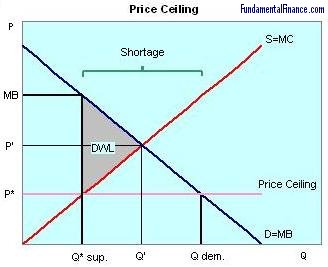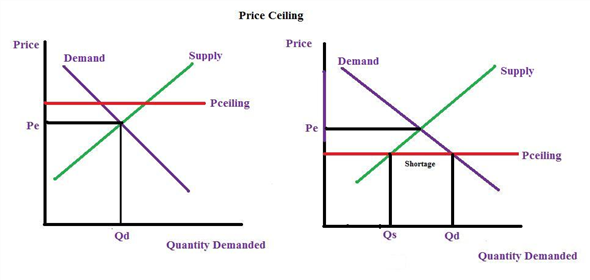Supply And Demand Graph With Price Ceiling

First let s use the supply and demand framework to analyze price ceilings.
Supply and demand graph with price ceiling. Price ceilings and price floors. Graphical representation of an ineffective price ceiling. The ceiling price is binding and causes the equilibrium quantity to change quantity demanded increases while quantity supplied decreases. The equilibrium outcome prevails.
The supply curve shifts to the right. When a price ceiling is imposed above the equilibrium price a shortage results. The original price is p but with the price ceiling the price falls to pmax and the quantity supplied is qs and the quantity demanded is qd. A price ceiling is a legal maximum price that one pays for some good or service.
A price ceiling is said. Price ceiling is a measure of price control imposed by the government on particular commodities in order to prevent consumers from being charged high prices. It causes a quantity shortage of the amount qd qs. The demand curve shifts to the left.
Taxes and perfectly inelastic demand. How does quantity demanded react to artificial constraints on price. If the price is not permitted to rise the quantity supplied remains at 15 000. A price ceiling example rent control.
A price ceiling keeps a price from rising above a certain level the ceiling while a price floor keeps a price from falling below a certain level the floor. There is not enough information to determine the outcome. Price ceiling also known as price cap is an upper limit imposed by government or another statutory body on the price of a product or a service a price ceiling legally prohibits sellers from charging a price higher than the upper limit. A price ceiling is typically below equilibrium market price in which case it is known as binding price ceiling because it restricts price below equilibrium point.
The supply curve shifts to the left. Google classroom facebook twitter. Price ceiling can also be understood as a legal maximum price set by the government on particular goods and services to make those commodities attainable to all consumers. The original intersection of demand and supply occurs at e 0 if demand shifts from d 0 to d 1 the new equilibrium would be at e 1 unless a price ceiling prevents the price from rising.
Taxation and deadweight loss. The price ceiling graph below shows a price ceiling in equilibrium where the government has forced the maximum price to be pmax. In addition a deadweight loss is created from the price ceiling. All else being equal i e.
Thus the actual equilibrium ends up below market equilibrium. The size of the shortage created by a price ceiling also depends on the elasticities of supply and demand.


















:max_bytes(150000):strip_icc()/Price-Ceilings-3-56a27d843df78cf77276a35b.png)